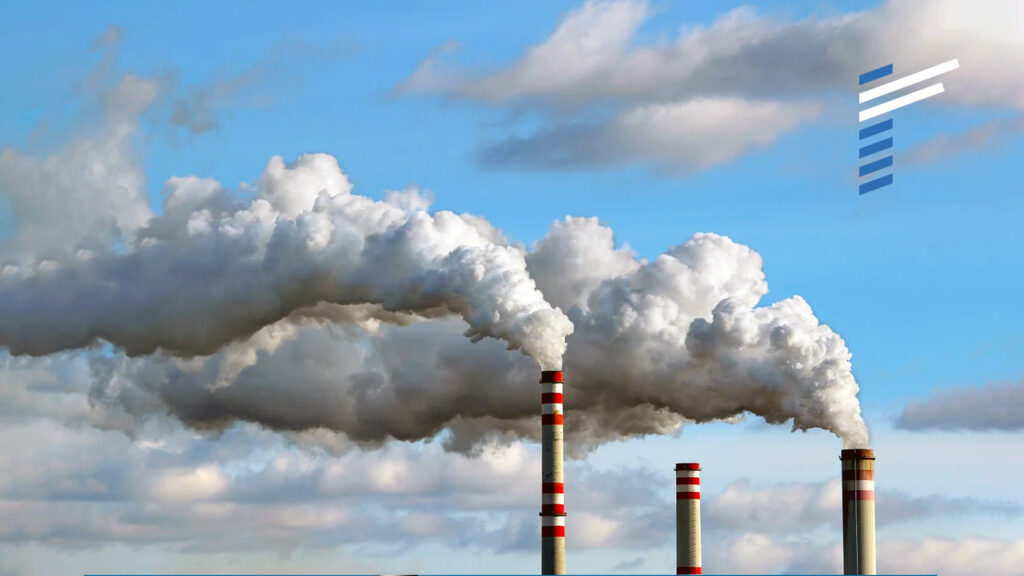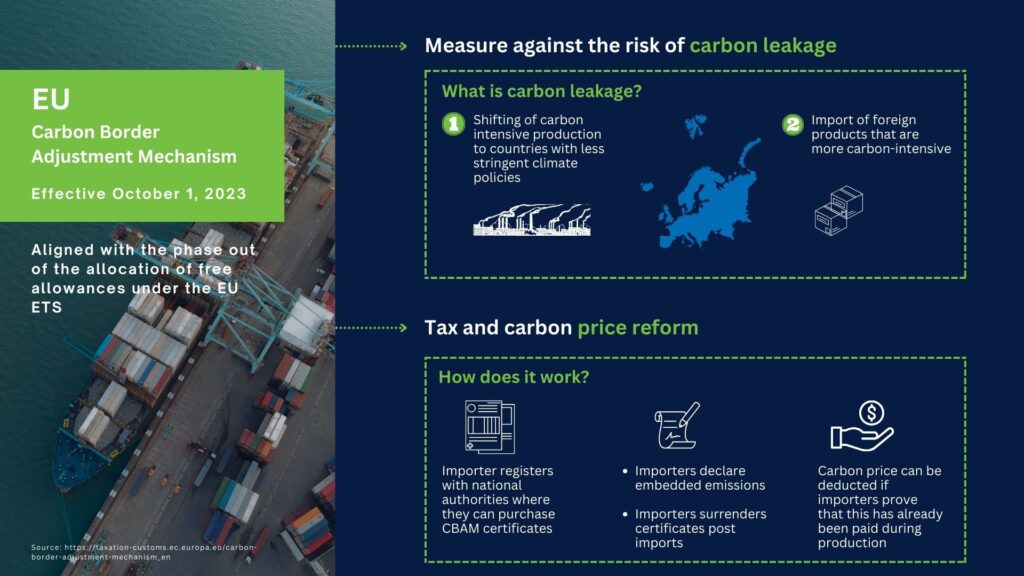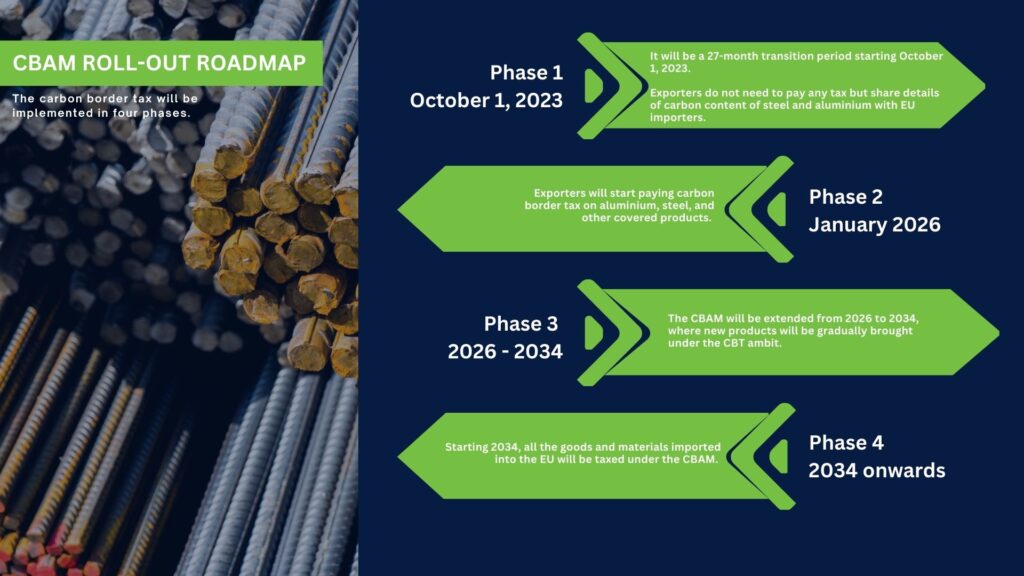We are running a series on the Carbon Border Adjustment Mechanism (CBAM). In this first article of the series, we discuss this mechanism in detail, including the roll-out timeline, coverage, processes, and reporting requirements. In subsequent parts of this series, which will be published soon, we will discuss the impact of CBAM on various industry players across different parts of the world.
At a Glance
- The EU introduced the Carbon Border Adjustment Mechanism effective October 1, giving them the authority to impose a Carbon Border Tax on certain imported goods.
- It will be rolled out in four phases, with initial implementation targeting specific products in carbon-intensive sectors.
- The introduction of the CBAM has significant short- and long-term implications on supply chains around the world: increased costs, supply chain dynamics, and more.
Climate change is a global challenge that demands coordinated efforts to reduce greenhouse gas emissions. However, as the European Union (EU) intensify their climate ambitions, there is a concern known as “carbon leakage.” Carbon leakage occurs when businesses in regions with stringent climate policies, like the EU, relocate carbon-intensive production to countries with less rigorous regulations or when carbon-intensive imports replace domestically produced goods.
To tackle this concern, the EU has introduced the Carbon Border Adjustment Mechanism (CBAM) that comes into effect on October 1, an innovative measure that grants the EU the authority to levy a Carbon Border Tax (CBT) on certain imported goods. CBAM is at the core of the EU’s ‘Fit for 55’ legislative package, which is designed with the primary goal of cutting greenhouse gas emissions by a minimum of 55% by 2030.
The Carbon Border Adjustment Mechanism (CBAM)
The EU has introduced the world’s first Carbon Border Adjustment Mechanism (CBAM) to tackle carbon leakage. The CBAM is designed to prevent “carbon leakage” by imposing tariffs on carbon-intensive products. The scheme aims to encourage manufacturers to adopt greener practices by mirroring the EU’s carbon market price. Companies from countries with equivalent carbon pricing mechanisms to the EU’s may be exempt from CBAM requirements.
CBAM will be rolled out in four phases, with each phase expanding its coverage:
Phase 1: Initial implementation targeting specific products in carbon-intensive sectors.
Phase 2: Broadening the coverage to include additional products and sectors.
Phase 3: Expanding CBAM to encompass more products and sectors at risk of carbon leakage.
Phase 4: Full implementation, covering a comprehensive range of products and sectors.
CABM will initially cover several specific products in some of the most carbon-intensive sectors, as follows:
- Iron and steel (including some downstream products)
- Cement
- Fertilizers
- Aluminium
- Electricity
- Hydrogen

What you need to know about Carbon Border Adjustment Mechanism (CBAM)

Ready for a change in your organisation?
The CBAM Process
The key steps in the CBAM process are:
1. Registration: EU importers of goods subject to CBAM must register with national authorities to participate in the CBAM system.
2. Certificate Purchase: Importers are required to purchase CBAM certificates, priced according to the EU’s carbon market allowance.
3. Emissions Declaration: Importers declare the embedded emissions in their imported goods according to CBAM regulations.
4. Certificate Surrender: Importers must surrender CBAM certificates based on the emissions they declared. This ensures accountability for the carbon footprint of imported goods.
5. Exemptions for Equivalent Carbon Pricing: Importers from countries with equivalent carbon pricing mechanisms may be exempt from purchasing CBAM certificates.
CBAM Reporting Requirements
Under the CBAM regulations, the entity responsible for declaring CBAM-related information is required to submit the following information on a quarterly basis during the transitional phase until January 2026:
- The total quantity of each specific type of good, delineated by the production facility responsible for manufacturing those goods in the country of origin.
- The direct emissions embedded per metric ton of each specific type of goods.
- The indirect emissions embedded in the goods, originating from third-party sourced electricity.
- The carbon pricing information paid within the country of origin for the embedded emissions present in the imported goods.
Furthermore, the entity responsible for CBAM declarations must ensure that the cumulative embedded emissions reported in the CBAM declaration are adequately substantiated and supported by verifiable data.
The introduction of CBAM has significant short-term impacts on supply chains across the globe:
- Increased Costs: CBAM introduces additional costs in the form of carbon taxes and supply disruption which may be passed on to consumers, potentially raising the prices of goods.
- Technology Upgradation: To remain competitive and avoid CBAM-related costs, manufacturers may need to upgrade technology to reduce carbon emissions in their products and processes.
- Measurement and Reporting Systems: Robust systems for measuring and reporting emissions are essential for compliance with CBAM, adding complexity to supply chain management.
- Supply Chain Dynamics: Manufacturers may shift to more carbon-efficient suppliers to reduce the carbon intensity of their products.
How Renoir Can Help Prepare for CBAM
Renoir, a trusted partner in your ESG journey, offers a range of expertise and support for CBAM:
- Strategic and Operational Guidance: We provide expert guidance on CBAM risks and opportunities, drawing on our global and cross-functional knowledge.
- Global Industry Expertise: Our extensive multinational experience enables us to guide and support you across global supply chains.
- Contract Due Diligence: We establish and review contract clauses to ensure the exchange of required information and the implementation of necessary systems and provisions for robust monitoring, reporting, and verification for CBAM.
- Process Improvement and Decarbonization: We help you enhance emission performance by improving processes and supplies with a transformative approach.
- Capacity Building and Training: We offer training and capacity development at all organizational levels, covering various aspects of ESG.
CBAM represents a seismic shift in the landscape of global trade and climate action. CBAM is expected to act as an accelerator in transforming global supply chains towards a circular economy. As businesses and countries prepare to navigate this transformative change, Renoir stands as a trusted partner, ready to facilitate the journey towards a sustainable future.
Stay tuned for the next part of this series.
This article is written by Jagpreet Walia.
Imad Alfadel is the Managing Partner ESG Practice at Renoir Consulting. With over two decades in the financial and consulting sectors, Imad has been supporting companies in enhancing their ESG performance. Through a hands-on approach at Renoir, he supports clients in realizing their ESG ambitions and transforming them into tangible results.
Jagpreet Walia is Partner ESG at Renoir Consulting. As a techno-strategic expert, he has experienced working with clients across emerging and developed markets, leading sustainability, green finance, adaptation, climate risk and decarbonization programs across public and private sectors. His expertise to empower businesses to thrive with collaboration and innovation helps in delivering sustainable impactful results.
Want to understand how your organisation should prepare for CBAM?













